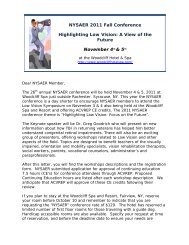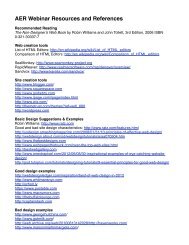Association for Education and Rehabilitation of the ... - AER Online
Association for Education and Rehabilitation of the ... - AER Online
Association for Education and Rehabilitation of the ... - AER Online
You also want an ePaper? Increase the reach of your titles
YUMPU automatically turns print PDFs into web optimized ePapers that Google loves.
Assessment Reliability <strong>and</strong> Fidelity<br />
to existing instruments are <strong>of</strong>ten used; however,<br />
resulting in<strong>for</strong>mation must be interpreted with caution<br />
due to <strong>the</strong> alteration <strong>of</strong> st<strong>and</strong>ardized procedures<br />
(Geenens, 1999; Mar, 1996). Moreover, such<br />
adapted instruments <strong>of</strong>ten result in in<strong>for</strong>mation that<br />
underestimates potential (Linder, 2008; Mar, 1996;<br />
Nelson, van Dijk, McDonnell, & Thompson, 2002; R.<br />
van Dijk, Nelson, Postma, & van Dijk, in press).<br />
Finally, st<strong>and</strong>ardized instruments may be both<br />
inaccurate <strong>and</strong> biased because <strong>the</strong>y do not account<br />
<strong>for</strong> <strong>the</strong> impact that each disability has on every area<br />
<strong>of</strong> development (Fraiberg, 1977; Linder, 2008;<br />
Nelson, van Dijk, McDonnell, et al., 2002).<br />
In an attempt to ameliorate such difficulties, Dr.<br />
Jan van Dijk <strong>and</strong> colleagues in The Ne<strong>the</strong>rl<strong>and</strong>s<br />
developed an alternative approach to assessment<br />
that has become known as <strong>the</strong> van Dijk Assessment<br />
<strong>of</strong> Children <strong>and</strong> Youth with Multiple Disabilities <strong>and</strong><br />
Deaf-Blindness (Nelson & van Dijk, 2002; Nelson,<br />
van Dijk, McDonnell, et al., 2002; Nelson, van Dijk,<br />
Oster, et al., 2009; J. van Dijk, Klomberg, & Nelson,<br />
1997). The assessment approach began as a<br />
cognitive one based on <strong>the</strong>ories <strong>of</strong> Werner <strong>and</strong><br />
Kaplan (1963) <strong>and</strong> Piaget (1964) <strong>and</strong> evolved to<br />
include <strong>the</strong>ories <strong>of</strong> social learning, transaction,<br />
attachment, <strong>and</strong> neurobiology (Nelson, van Dijk,<br />
Oster, et al., 2009). It is used throughout <strong>the</strong> world<br />
<strong>and</strong> has been translated into Dutch, Russian,<br />
Spanish, <strong>and</strong> Polish (Nelson & van Dijk, 2002).<br />
The assessment process is family as well as child<br />
guided. It begins with a family interview that includes<br />
in<strong>for</strong>mation about <strong>the</strong> child <strong>and</strong> his or her<br />
preferences <strong>and</strong> also attempts to discover what<br />
family members hope to learn about <strong>the</strong> child from<br />
<strong>the</strong> assessment. The assessment <strong>the</strong>n proceeds to<br />
follow <strong>the</strong> lead <strong>and</strong> interests <strong>of</strong> <strong>the</strong> child ra<strong>the</strong>r than a<br />
prescribed protocol with prescribed materials. Assessors<br />
using <strong>the</strong> van Dijk framework <strong>for</strong> assessment<br />
constantly adjust <strong>the</strong>ir emotions, cognitive<br />
levels, <strong>and</strong> communications to those <strong>of</strong> <strong>the</strong> child as<br />
<strong>the</strong>y build conversations or interactions that incrementally<br />
build upon <strong>the</strong> child’s interests (MacFarl<strong>and</strong>,<br />
1995; Nelson & MacFarl<strong>and</strong>, 1997; Nelson & van<br />
Dijk, 2002). The assessment examines <strong>the</strong> processes<br />
individuals use as <strong>the</strong>y learn <strong>and</strong> develop. These<br />
processes include (a) maintaining <strong>and</strong> modulating<br />
state, (b) using preferred learning channels, (c)<br />
learning, remembering, <strong>and</strong> anticipating routines, <strong>and</strong><br />
(d) accommodating new experiences with existing<br />
72 | <strong>AER</strong> Journal: Research <strong>and</strong> Practice in Visual Impairment <strong>and</strong> Blindness<br />
schemes. Also examined are <strong>the</strong> child’s abilities to<br />
<strong>for</strong>m attachment, interact socially, communicate with<br />
o<strong>the</strong>rs, <strong>and</strong> solve problems. The end result <strong>of</strong> <strong>the</strong><br />
assessment is a written summarization <strong>of</strong> <strong>the</strong> child’s<br />
strengths <strong>and</strong> needs in each <strong>of</strong> <strong>the</strong> assessed areas,<br />
next steps <strong>for</strong> intervention, <strong>and</strong> specific suggestions<br />
<strong>for</strong> intervention (Nelson & van Dijk, 2002; Nelson,<br />
van Dijk, McDonnell, et al., 2002; Nelson, van Dijk,<br />
Oster, et al., 2009; Silberman, Bruce, & Nelson,<br />
2004; Westling & Fox, 2009). Specific questions<br />
asked in <strong>the</strong> assessment are provided in Table 1<br />
(Nelson, van Dijk, McDonnell, et al., 2002).<br />
The fluid nature <strong>of</strong> <strong>the</strong> van Dijk assessment<br />
creates significant challenges <strong>for</strong> evaluation <strong>of</strong> its<br />
reliability. There is no prescribed protocol, implementation<br />
order, or specific testing materials. Each<br />
assessment is by design unique because <strong>the</strong><br />
assessor must follow <strong>the</strong> child’s interests <strong>and</strong> leads,<br />
thus making it difficult to ascertain whe<strong>the</strong>r <strong>the</strong><br />
assessment was implemented correctly. There<strong>for</strong>e, it<br />
is important that techniques deemed critical to<br />
successful implementation <strong>of</strong> <strong>the</strong> assessment be<br />
identified <strong>and</strong> delineated. Similarly, <strong>the</strong>re is no set<br />
interpretation scale. The assessor must be able to<br />
extract qualitative measures <strong>of</strong> <strong>the</strong> child’s learning<br />
processes <strong>and</strong> needs from each observed assessment.<br />
Consequently, an evaluation <strong>of</strong> <strong>the</strong> reliability <strong>of</strong><br />
<strong>the</strong> instrument must determine whe<strong>the</strong>r multiple<br />
examiners can look at <strong>the</strong> same assessment <strong>and</strong><br />
come to similar conclusions.<br />
The purpose <strong>of</strong> <strong>the</strong> current study is to establish<br />
whe<strong>the</strong>r <strong>the</strong> van Dijk approach to assessing children is<br />
a reliable instrument <strong>for</strong> use with <strong>the</strong> population <strong>of</strong><br />
individuals who have severe multiple disabilities<br />
including sensory impairments. To accomplish this<br />
purpose, <strong>the</strong> study is designed to answer <strong>the</strong> following<br />
questions: (a) What are <strong>the</strong> specific quality indicators<br />
<strong>for</strong> successful assessments using this framework? (b)<br />
Are practitioners able to implement <strong>the</strong> assessment<br />
with fidelity or adherence to elements considered<br />
crucial to its effectiveness? (c) Are multiple examiners<br />
reliably able to reach <strong>the</strong> same conclusions regarding<br />
<strong>the</strong> presence or nonpresence <strong>of</strong> <strong>the</strong> quality indicators?<br />
<strong>and</strong> (d) Are multiple examiners able to look at <strong>the</strong><br />
same child assessment <strong>and</strong> reliably come to similar<br />
conclusions?<br />
In order to answer <strong>the</strong> first question, three<br />
individuals considered to be authorities on <strong>the</strong><br />
approach, Drs. Jan van Dijk, Ca<strong>the</strong>rine Nelson,







